Boxing Clever, Round 1: Thinking inside the box
From the handmade to the mass-produced, bespoke archival boxes protect books in collections, libraries, and archives across the globe. Here at the Cambridge University Library, the Collection Care team creates boxes for books in need of extra protection.
Why do books need boxes?
Every avid reader knows that not every old book can keep itself together: pages tear, dust collects, and old leather powders and flakes away. Not to mention the structural issues that build up over decades (or centuries or millennia!) of being handled; after enough use, it is common for the functionality of the book to start breaking down. In addition to the strains of being read, books in a library collection are kept upright on shelves, packed tightly between other books so that even sliding it on and off the shelf can cause further damage to a vulnerable book. Boxes allow each book to have a specially-made container which has the ability to address many of these issues on a case-by-case basis.
The most basic types of boxes serve primarily as a shield: they keep dust and pests out and allow for easier shelving and stacking. They can also help keep any loose pages or extra inserted materials with their respective objects and prevent them from being lost. Many books that are in need of further conservation treatment are often housed in simple boxes to protect them until they can be stabilised by our Conservation team. These basic boxes are usually made of acid-free archival board, which is a relatively inert material that will not chemically accelerate degradation (keep an eye out for their distinctive blue-grey colour out in the stacks!).
More features can be added to boxes to mitigate specific problems, for example, the pages of a heavy book may cause significant stress on its spine over time but a box can be built with a supplementary support for the pages so the spine no longer has to bear their weight. For more valuable rare books and manuscripts, sturdier, more elaborate boxes are made by hand to serve as their permanent containers. These are built with strength and longevity in mind, and are often made from much thicker board and covered in book cloth. In addition to added protection and support, these boxes also serve as impressive presentation cases for important books in the collection. The tradition of box making by hand goes back generations, and many institutions use their own preferred or signature design. The drop-spine boxes used at the University Library are made from a plan that has been used here for decades, and continues to be made today.
Some box history
Box making in some form has been around since there were things to put in boxes but preservation box making is generally considered to be descended from the boxes designed by Swedish botanist Daniel Solander. Solander had accompanied Captain Cook on his voyages to Australia, and upon his return created a box to contain his botanical samples; this simple design of a box with a spine that would drop flat when opened became known as a Solander box (or drop-spine or clamshell box), and is very similar to those which we make at the University Library to this day.
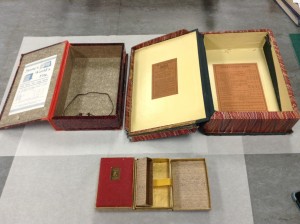
Several historical boxes meant to hold documents (top row) and two decks of playing cards (bottom row)
Many other forms of boxes were used to house books and documents over the centuries, some with very interesting and creative features. Three examples from the 20th century are shown here, two document storage boxes and one meant to house two decks of playing cards. Some commercial boxes imitated the look of a bound book for attractive shelf storage. Both of the document boxes shown here have solutions for packing down the papers inside: one has a spring-loaded metal clip, and the other a sliding mahogany wood bar. The playing card box is especially clever, and contains a ribbon attached to the underside of a small inner box that lifts up the deck of cards when the box is opened and lays it flat when it is closed. These boxes all come from the private collection of one of the Collection Care team members.
Making boxes with Collections Care
The Collection Care team works with the Manuscripts and Rare Books department to select a group of vulnerable books that need re-housing. These can be unhoused books in need of enclosure but just as often we take in books that have damaged boxes that need replacing. We then remove them to the studio, where each book is carefully measured and inspected for any features that may need to be accommodated specifically. For example, for books with loose additional material we create a small drawer in the bottom of the box to house it, which allows for easier handling of the book while keeping all the materials together in the same box. Over-sized boxes for large and/or heavy books are specifically reinforced to accommodate their size and weight, with recesses cut in the walls to allow a reader to easily lift the object out without needless stress on the book. One especially large box we made recently required several people to help cover it! More specialised formats require unique and specific solutions; for example, South Asian palm leaf manuscripts are supported by supplementary cushioned wraparound sleeves which provide extra stability for the delicate edges of the pages. These are then placed in a box, which provides a gentle pressure to keep the manuscripts upright and safe.
These are only a small selection of the infinite amount of solutions available when it comes to protecting vulnerable objects, and the incredible variety of the University Library collections allows us to constantly refine and adapt our techniques to protect the objects in our care for future generations of readers.

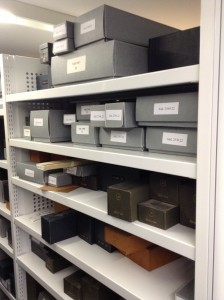
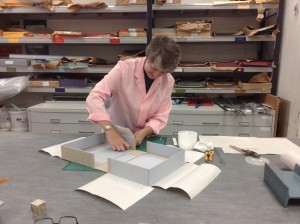
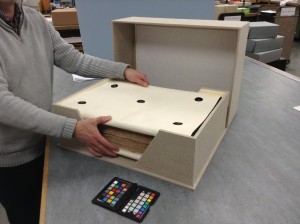
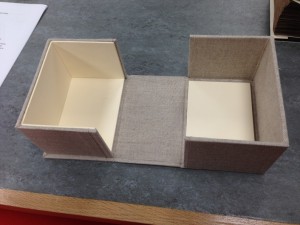
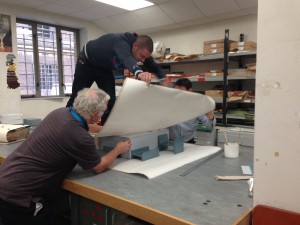
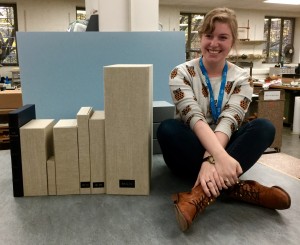
What a concise and extremely informative and well written report. A subject I would not normally know much about but having read this am now interested to know more. I look forward to future reports.
Please keep me informed about related book/box making subjects as I really enjoyed this blog, and for clearing up the origin of the name ‘ Solander’.
Regards
Clive Owen